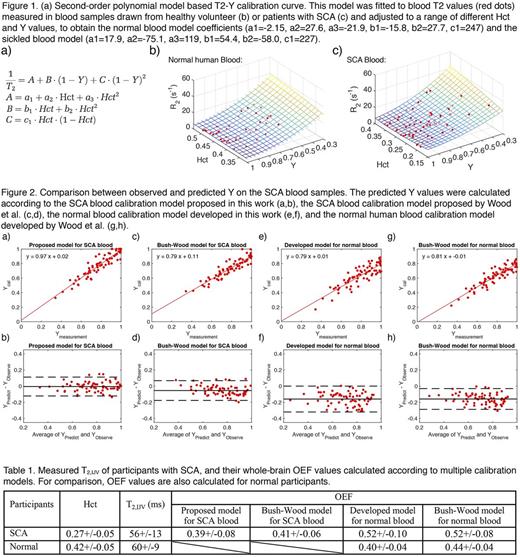Abstract
Introduction
An increased oxygen extraction fraction (OEF) is an indicator of decreased cerebrovascular reserve and may help predict the risk of cerebral infarction in people with sickle cell anemia (SCA). MRI T2 oximetry can conveniently convert measured venous blood T2 values to venous oxygenation fraction (Yv) using predetermined hematocrit (Hct)-dependent calibration curves. Previously, calibration models established for healthy adults and neonates were applied to people with SCA. However, a recent study on SCA blood showed T2 dependence on Y, but not on Hct (Bush et al. ISMRM, 2017, #1898). This might be due to the variations in disease history and treatment status of the SCA cohort in that study. Here, we established a calibration curve specific to people with SCA without a history of stroke or recent transfusion. Whole-brain OEFs for individuals with SCA were derived using this calibration model.
Methods
Experiments were performed on a 3T Philips Achieva scanner. Thirteen healthy volunteers (35 ± 8 yrs; 7M / 6F; Hct: 0.42+/-0.03) and ten people with SCA (25 ± 7 yrs; 4M / 6F; HbS: 82%+/-7%; HbF: 9%+/-4%; Hct: 0.24+/-0.05) with no history of stroke, recent transfusion, or renal impairment were enrolled after informed consent.
Venous blood T2 values were measured in the internal jugular vein (IJV) using a 48 sec protocol (Qin et al. MRM, 2011, 65:471). In vitro T2 measurements were conducted on the same day on venous blood drawn from the healthy volunteers and patients with SCA under physiological conditions (T=37ºC) following established protocols. Nitrogen and air gas were used to prepare different oxygenation levels (ranging from ~50% to 100%) for each blood sample. CPMG experiments in vitro were performed within 1 min to prevent sedimentation of erythrocytes. Blood oxygenation was measured immediately after every measurement using a blood analyzer. Blood T2 values measured in vitro from both normal and SCA samples were separately fitted relative to Y and Hct using an empirical model proposed by Lu et al. (MRM, 2012, 67:42) (Fig. 1a). Then venous blood T2 values in healthy volunteers and people with SCA were converted to Yv using these calibration curves from normal and SCA blood and their individual Hct. The whole-brain OEF was calculated as 1-Yv.
Results
Good fitting was obtained for the results of the in vitro experiments. The relationship between blood T2, Y and Hct for both the normal and SCA blood samples are illustrated with surface plots in Figs. 1b,c. The red dots indicate the experimental data points and the mesh shows the model-fitted surface.
In a Bland-Altman plots comparison of the predicted and measured Y for SCA blood samples, our calibration model for SCA blood corresponded well (Figs. 2a,b), while the SCA calibration model based on mixed SCA blood (Bush et al. ISMRM, 2017, #1898) (Figs. 2c,d) had a slight underestimation (~5%), and both the normal blood calibration models developed in this work and by Bush et al. (Bush et al. MRM, 2017, Epub ahead) underestimated Y by 10%-20% (Figs. 2e-h).
Using our SCA in vitro blood model, the averaged whole-brain OEFs of participants with SCA were measured as 0.39+/-0.08 (Table 1), similar to the result (0.41+/-0.06) based on Bush-Wood SCA model, but 25% lower than the values of 0.52 estimated using a calibration models based on normal human blood. Participants with SCA showed similar whole-brain OEF (0.39+/-0.08 vs 0.40+/-0.04) with greater variation among participants (P<0.004, Table 1).
Discussion and Conclusion
We developed an empirical blood T2-Y calibration model for SCA blood. For people with SCA, underestimations of Yv or overestimations of OEF were observed when using developed calibration models based on normal blood. This may be caused by the sickle erythrocytes' irregular shape and degree of hemoglobin S polymerization, which require specific calibrations. The average whole-brain OEF values estimated using our SCA blood calibration model did not differ significantly from healthy volunteers, which is consistent with an earlier PET study (Stroke 1986, 17:692), but contradictory to an earlier T2 oximetry study (Brain, 2016, 139:738) using a calibration model derived from normal blood.
Strouse: Sickle Cell Adult Provider Network: Membership on an entity's Board of Directors or advisory committees; HRSA-Sickle Cell Treatment Demonstration Program: Research Funding.
Author notes
Asterisk with author names denotes non-ASH members.


This feature is available to Subscribers Only
Sign In or Create an Account Close Modal